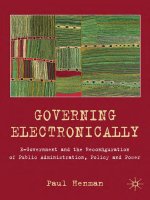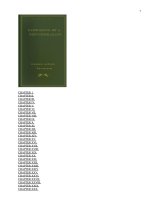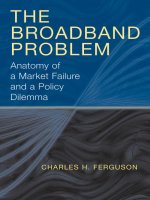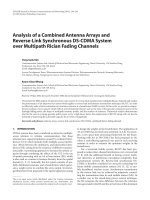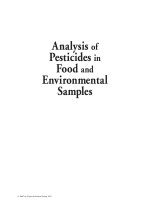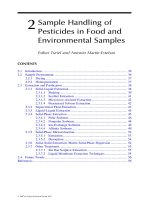Exergoeconomic analysis of a combined water and power plant 2
Bạn đang xem bản rút gọn của tài liệu. Xem và tải ngay bản đầy đủ của tài liệu tại đây (758.17 KB, 123 trang )
A THESIS SUBMITTED
A
THESIS
SUBMITTED
FOR THE DEGREE OF DOCTOR OF PHILOSOPHY
Acknowledgements
i
ACKNOWLEDGEMENTS
The author would like to express his profound gratitude and appreciation to his
supervisor and mentor Associate Professor M.N.A. Hawlader for his invaluable
guidance, supervision and inspiration. He also would like to thank his co-supervisor
Professor A. S. Mujumdar for his supervision and inspiration.
The author would like to extend his gratitude to the FYP students working on this
project, Mr. Chang He, Mr. Ang Boon Wee, Mr. Kuan Sien. He is also thankful for
the technical help received from Mr. Yeo Khee Ho and Mr. Chew Yew Lin, Thermal
Process Lab1 and Mr. Tan Tiong Thiam, Energy Conversion Lab.
Finally, the author would like to express his heartfelt gratitude to his family members
whose inspirations have helped him to carry on studies at this level.
Table of Contents
ii
Table of Contents
ACKNOWLEDGEMENTS
TABLE OF CONTENTS
SUMMARY
NOMENCLATURE
LIST OF FIGURES
LIST TO TABLES
i
ii
viii
x
xv
xxiv
Chapter
Chapter
1
1.1
1.2
1.3
2
2.1
2.2
2.3
2.4
2.5
2.6
2.7
2.8
2.9
2.10
INTRODUCTION
Background
Research objectives
The Scope
LITERATURE REVIEW
Combined Water and Power Plant
Desalination Processes
Thermal desalting processes
2.3.1 Multistage flash distillation (MSF)
2.3.2 Multi-effect distillation (MED)
2.3.3 Comparisons of MED and MSF
Reverse Osmosis (RO)
Simulation of Thermal Desalting Process
Experimental investigations
Waste heat utilization in MED
Heat transfer augmentation
Exergy Analysis of Desalination Plants
Exergoeconomic Analysis
1
1
4
6
7
7
8
9
10
11
13
14
17
19
20
23
27
29
Table of Contents
iii
Chapter
2.11
3
3.1
3.2
3.3
3.4
3.5
3.6
3.7
3.8
3.9
3.10
3.11
Summary
MODELING AND SIMULATION
Gas Turbine Plant
Steam Cycle
Part Load Calculations
3.3.1 Gas Turbine Plant
3.3.2 Steam Turbine Plant
Combined Water and Power Plant
MED Mathematical Model
3.5.1 Overall Plant Calculations
3.5.2 Individual Effect Calculations
Exergy Analysis of thermal desalination processes
Vertical Single tube heat exchanger
3.7.1 Water Temperature variation
3.7.2 Two-phase flow: vapor generation
3.7.3 Model for Pressure drop in two phase region
3.7.4 Heat Transfer Coefficient for Tubes with Inserts
3.7.5 Experimental & Theoretical Overall Heat Transfer
Coefficients
Performance Ratio
Water Production Rate
Specific Heat Transfer Area
Mathematical Model of Reverse Osmosis (RO) system
3.11.1 Average volumetric flux
3.11.2 Average salt flux
30
32
35
38
41
41
42
43
44
44
46
49
57
59
67
71
76
78
79
79
80
80
82
82
Table of Contents
iv
Chapter
Chapter
4
4.1
4.2
4.3
4.4
4.5
4.6
5
5.1
3.11.3 Correlations
3.11.4 Permeate Concentration
3.11.5 Product flow rate
3.11.6 Concentration of reject flow
3.11.7 Determining the number of RO modules
3.11.8 Simulation Procedure
3.11.9 Exergy Analysis for a RO module
3.11.10 Exergoeconomic Model of RO plant
EXPERIMENT
The Desalination Unit
4.1.1 Operation of the desalination unit
4.1.2 Specifications of the components
Design of the components
Test procedure
Vertical Single tube heat exchanger
Uncertainty analysis
Experiments on Reverse Osmosis system
4.6.1 Operations of the RO system
4.6.2 Calibration of measuring instruments
4.6.3 Experimental program
4.6.4 Experimental procedure
4.6.5 Water analysis
RESULTS AND DISCUSSION
Combined cycle power plant: simulation results
5.1.1 Power plant simulation results
83
86
86
87
87
88
89
91
97
97
98
100
101
109
110
124
126
126
128
129
129
130
131
131
133
Table of Contents
v
5.2
5.3
5.4
5.5
5.1.2 Power plant simulation: validation with Thermoflow®
Combined water and power plant: simulation results
5.2.1 Effect of Combined cycle load on Thermal Efficiency
5.2.2 Combined Water and Power Plant (CWPP):
comparison of performance with Rensonnet et al. (2007)
5.2.3 Effect of Combined cycle load on Water Production
5.2.4 Electricity cost variation with Oil Price
Experimental results of MED
5.3.1 Effect
of Heating Medium Flow Rate
5.3.2 Effect of Heating Medium Temperature
5.3.3 Effect of Feed Flow Rate
5.3.4 Effect of feed temperature and flashing
5.3.5 Effect of top-brine temperature
5.3.6 Effect of variable concentration
Thermal hydraulic performance comparisons for different
tube profiles
5.4.1 Feed temperature distribution inside the tube
5.4.2 Variation of vapour quality along the length of the
tube
5.4.3 Shell side heat transfer coefficient
5.4.4 Tube side heat transfer coefficient
MED parametric evaluation
5.5.1 Distillate production with varying number of effect
5.5.2 Effect of Top Brine Temperature on Distillate
production
5.5.3 Effect of Top Brine Temperature on exergy efficiency
133
134
135
136
137
138
139
140
143
146
149
152
154
157
157
159
160
161
163
163
164
165
Table of Contents
vi
Chapter
5.6
5.7
5.8
6
5.5.4 Exergy efficiency for varying number of effects
5.5.5 Cost per unit exergy for varying number of effects
5.5.6 Overall heat transfer coefficient for varying number
of effects
Experimental Results for single tube vertical heat exchanger
5.6.1 Effect of Heating Medium Temperature
5.6.2 Effect of insertions on water production
5.6.3 Effect of heating medium flow rate on Overall heat
transfer coefficient
5.6.4 Effect of Feed Temperature
5.6.5 Effect of Feed Flow Rate
5.6.6 Effect of Insertions and Corrugated Tube Profile
5.6.7 Effect of Corrugation Pitch and Depth
RO parametric evaluation
5.7.1 Validation of the RO simulation program
5.7.2 Effect of Feed Flow rate
5.7.3 Effect of Feed pressure
5.7.4 Effect of Feed pressure and flow rate on water cost
5.7.5 Effect of Volumetric flow rate on exergy efficiency
Optimization of the CWPP plant
5.8.1 Optimization study of the MED plant
5.8.2 Fuel Cost sensitivity on the water cost
CONCLUSIONS
166
166
167
168
169
170
172
176
180
184
186
187
187
189
189
191
191
192
192
194
196
RECOMMENDATIONS 198
Table of Contents
vii
REFERENCES
APPENDIX A MED simulation program
APPENDIX B Calibration gr
aph
APPENDIX C
Uncertainty analysis
APPENDIX D Spiral Wound Membrane Specification
APPENDIX E MED Experimental Results
APPENDIX F Property functions of Seawater
APPENDIX G Heat transfer characteristics of tubes
199
208
214
219
224
226
237
241
Summary
viii
SUMMARY
The efficiency of a combined cycle (CC) power plant depends to a great extent on the
production of electricity. Under part-load operation of the power plant, the efficiency
is affected significantly. Developments in desalination methods such as the Reverse
Osmosis (RO) require electricity to produce water. Moreover, thermal desalination
system like MED (multi-effect distillation) requires low grade heat source eg. waste
heat from power plant. So, an integrated system (Combined water and power
plant,CWPP) offers synergistic improvement. A simulation model was developed to
predict the performance of the system, which includes both power and water.
Computations indicated that the performance can be improved with the integration of
MED and RO.
When MED and RO plants are coupled to the combined power plant, the thermal
efficiency of the plant increases by about 15%. This leads to a lower cost of water
production, which is about 0.63 US$/m
3
. The study of the CWPP has shown that, the
CC+MED+RO produce the distillate and the electricity with the lowest cost under the
set conditions. Also, CC+MED+RO exhibits maximum overall exergetic efficiency.
Experimental investigation of the MED system reveals the significant effect of
flashing on the overall performance of the system. For a 10
0
C superheat of the feed
water, the system produces 41.45 kg/hr of fresh water from an effective heat transfer
area of 5.32 m
2
with a performance ratio of 1.45 in the corrugated profile. The
performance ratio was found to increase significantly during the preheating of the
feed temperature.
Experiments were performed with various salt concentrations of 15,000-35,000 ppm
to find the sensitivity of the system to feed water concentrations. Hot water was used
as the heating fluid in the shell and tube two-phase heat exchanger and the
Summary
ix
temperatures were varied between 47 and 85
0
C. The flow rates of the hot water were
varied from 1.5 to 3.5 m
3
/hr for the single effect experiment.
Four different types of tube-profiles were considered, such as, single-fluted
aluminum, smooth Copper-Nickel (90-10), Corrugated Copper-Nickel and Poly-
Teflon (PTFE) coated aluminum. Moreover, inserts were used to further enhance the
heat transfer coefficient. The purpose was to find a better combination of tube
material and geometry for the design of a desalination unit utilizing waste heat from
the power plant.
A lab scale experimental set up for RO was designed to work with variable feed
concentration of 25,000ppm – 33,000ppm. The feed temperature and pressure were
varied from 26
o
C – 32
o
C, 48.16 bar to 56.16 bar, respectively. The performance of the
system was evaluated in terms of heating medium and feed water temperature and
flow rate, top brine temperature (TBT) and feed concentration.
Comparison between experimental and simulation results showed good agreement.
The RO experimental results showed that, feed pressure had strong positive impact
on the product flow rate and exergy destruction. Also, the exergetic efficiency
increases rapidly with increase of the feed flow rate.
Results showed that the use of a power plant coupled with MED and RO can save
about 20% energy savings. Moreover, it can reduce the water production cost by
about 23%. The simulation results for the optimization study reveals that, MED
performs better with total number of effects of 11.The product salt concentration was
in the range of 20-30 ppm. This experimental and simulation study indicated that, the
CWPP system could effectively be used as a probable solution for arid and semi arid
areas economically.
List of Symbols
x
NOMENCLATURE
A Area (m
2
)
B Baffle Spacing (m)
C Area correction factor for different tube profile
c Salinity or salt concentration (kgm
-3
)
C
p
Specific heat at constant pressure (kJkg
-1
k
-1
)
D Mass diffusion coefficient, (m
2
s
-1
)
D
S
Shell-side diameter (m)
P
∆
Pressure difference given by P
f
-P
p
(Pa)
eff
P∆
Effective pressure difference (Pa)
f Concentration gradient coefficient (kgm
-4
)
h Height (m) or enthalpy (kJ/kg)
J Average volumetric flux, (m
3
s
-1
)
J
2
Average salt mass flux, (kgm
-2
s
-1
)
k Mass transfer coefficient, ms
-1
or thermal conductivity, (W/ m K )
k’ C
p
/C
v
k
1
Water permeability coefficient, (ms
-1
bar
-1
)
k
2
Solute permeability coefficient, (ms
-1
)
List of Symbols
xi
k
f
Friction parameter, (m
-2
)
k
1m
Constant in water permeability coefficient
k
2m
Constant in salt permeability coefficient
k
m
Constant in mass transfer coefficient
L Membrane length (axial), (m)
LMTD Log mean temperature difference, ( K)
.
m
Mass flow rate, (kgs
-1
)
M Molecular mass, (kgkmol
-1
)
P Pressure, (Pa)
P
T
Pitch of the tube-bundle (m)
q A constant for RO (m), and heat for other cases (W)
Q Volume flow rate, (m
3
s
-1
)
R Universal Gas Constant, (kJkg
-1
K
-1
)
Re Reynolds number
s Specific entropy, ( kJ/kg.K)
S Entropy, (kJ/K)
Sc Schmidt number, (µ/ρD)
Sh Sherwood number, (kL/D)
T Temperature, (
o
C )
TBT Top brine temperature,(
o
C )
u Velocity,( ms
-1
)
List of Symbols
xii
U Overall Heat transfer coefficient, (kW/m
2
.K)
w Membrane width (tangential), (m) or specific work, (kJkg
-1
)
W Power output, (kW)
x Coordinate along the membrane length, m or quality of steam
X Exergy , (kW)
y Coordinate along the membrane width, (m)
Z Capital cost, (US$)
Greek letters
µ
Viscosity , (kgm
-1
s
-1
)
π
Osmotic pressure, (Pa)
ρ
Density, (kgm
-3
)
ω
Osmotic pressure coefficient, (Nmkg
-1
)
or rotating speed
η
Efficiency
β
Pressure ratio
γ
2857.0
1
'
'
=
−
k
k
Ψ
Specific exergy (kW/kg)
η
Efficiency
List of Symbols
xiii
Subscript
a,b,c,d,e State a,b,c,d,e
b Brine
bh Brine heater
bled Bled
cc Combined cycle power plant
comp Compressor
cond Condenser or condensate
d Discharge
des Destruction
dist Distillate
ef Effective
eff Effect
elec Electrical work
evap Evaporator
f Feed
fg Latent heat of evaporation
gen Generation
GT Gas turbine
II Exergy or second law
isen Isentropic
List of Symbols
xiv
m Membrane
o Dead state
p Permeate
pre Preheater
rej Reject
ST Steam turbine
steam Steam
sw Re-circulating brine / sea water
v Vapour
w Wall
1,2,3,4,5 State 1,2,3,4 and 5
Superscript
‘ State if an isentropic process took place or evaporation
“ Flashing
List of figures
xv
LIST OF FIGURES
Figure 2.1
Figure 2.2
Figure 2.3
Figure 2.4
Figure 2.5
Figure 2.6
Figure 3.1
Figure 3.2
Figure 3.3
Figure 3.4
Figure 3.5
Figure 3.6
Figure 3.7
Figure 3.8
Figure 3.9
Figure 3.10
Figure 3.11
Figure 3.12
Figure 3.13
Figure 3.14
Figure 3.15
Figure 3.16
Figure 3.17
Figure 3.18
Various Types of Desalting Processes
Installed Desalination Capacity by Process
Overall Scheme of seawater distillation
Schematic presentation of a Multi-Stage Flash desalination plant
Schematic presentation of a Multi-effect distillation (MED) plant
Schematic of a RO plant layout
Schematic of a combined water and power plant
Schematic Diagram of Combined Cycle Power Plant
T-s diagram of a Brayton Cycle
T-s diagram of a Rankine Cycle
T-s diagram of a Rankine Cycle (for bled steam)
A schematic summarizing the exergy flows into a MED plant
Schematic Diagram of Forward Feeding MED Plant
A schematic diagram of the exergy flow in the first effect
A schematic diagram of the exergy flows from the 2nd effect to
the 2nd last effect
A schematic summarizing the exergy flows into the last effect
A schematic summarizing the flow entering a pump
Energy balance on an element of the heat exchanger
Geometry of a corrugated tube
Diagram for quality generation
Diagram for pressure variation along tube-side
Smooth tube with insertions configuration dimensions.
Unwound spiral wound module (1 leave)
Flowchart of RO Mathematical Model
8
9
10
11
12
15
33
34
36
39
42
50
51
52
54
55
57
60
65
69
72
77
85
90
List of figures
xvi
Figure 3.19
Figure 3.20
Figure 3.21
Figure 4.1
Figure 4.2
Figure 4.3
Figure 4.4
Figure 4.5
Figure 4.6
Figure 4.7
Figure 4.8
Figure 4.9
Figure 4.10
Figure 4.11
Figure 4.12
Figure 4.13
Figure 4.14
Figure 4.15
Figure 4.16
Figure 4.17
Figure 4.18
Figure 4.19
Figure 4.20
Figure 4.21
Figure 4.22
A schematic summarizing the exergy flows in and out of the RO
module
Schematic Diagram of RO plant
Flowchart for simulation of combined water and power plant
Schematic diagram of the desalination system
A Photograph of the desalination Rig
A Photograph of the Evaporator
The layout of tubes inside the evaporator
Corrugated Cu-Ni (90-10) Tube-bundle
Schematic diagram of the feed water tank
Schematic diagram of the heating medium tank
A photograph of the Vacuum pump
A photograph of the Blowdown pump
Schematic of the single tube experimental setup.
Four different evaporator tubes used
Corrugated tube dimensions
Four smooth evaporator tubes of different materials
Two evaporator tubes of different corrugation depths
Three evaporator tubes of different corrugation pitch
A photograph of the insertions used in the experiment
Hot water bath
3D view of shell tube heat exchanger
Flow pattern within the shell tube heat exchanger.
RTDs are connected to this data logger
Flow meters to regulate the heating medium and feed flow rates
Vacuum pump
91
94
96
98
101
102
102
104
106
107
108
108
112
112
114
114
115
115
116
117
117
118
119
120
120
List of figures
xvii
Figure 4.23
Figure 4.24
Figure 4.25
Figure 4.26
Photograph of the experimental set up
Diagram showing different variable of the experimental set up
Schematic diagram of the RO desalination system
Photograph of the RO experitmental set up
121
125
127
128
Figure 5.1
Figure 5.2
Figure 5.3
Figure 5.4
Figure 5.5
Figure 5.6
Figure 5.7
Figure 5.8
Figure 5.9
Figure 5.10
Figure 5.11
Figure 5.12
Figure 5.13
Figure 5.14
Variation of thermal efficiency with Combined cycle load
Variation of Water Production with Combined cycle load
Electricity cost trend with varying barrel cost
Exergetic efficiency of power plants for different electrical loads
Variation of performance ratio and specific heat transfer area
with heating medium flow rate
Variation of fresh water production rate (kg/hr) with heating
medium flow rate
Variation of Overall heat transfer coefficient with heating
medium flow rate
Variation of fresh water production rate (kg/hr) with heating
medium temperature
Variation of concentration factor with heating medium
temperature
Variation of fraction of equilibrium with the heating medium
temperature
Variation of performance ratio with feed flow rate
Variation of fraction of equilibrium with feed flow rate
Variation of specific heat transfer area and concentration factor
with feed flow rate
Variation of performance ratio with feed temperature
135
137
138
139
141
142
143
144
145
146
147
148
148
149
List of figures
xviii
Figure 5.15
Figure 5.16
Figure 5.17
Figure 5.18
Figure 5.19
Figure 5.20
Figure 5.21
Figure 5.22
Figure 5.23
Figure 5.24
Figure 5.25
Figure 5.26
Figure 5.27
Figure 5.28
Figure 5.29
Figure 5.30
Figure 5.31
Figure 5.32
Figure 5.33
Variation of Overall heat transfer coefficient with feed
temperature
Variation of Performance ratio with feed temperature
Variation of flashing efficiency with the feed temperature
Variation of fresh water production with top brine temperature
Variation of performance ratio with top brine temperature
Variation of production rate on variable concentration
Variation of BPE and fraction of equilibrium with concentration
Variation of product water concentration with variable
concentrations of feed
Variation of the feed water temperature along the length of the
tube
Variation of the feed water temperature along the length of the
tube
Variation of quality along the length of the tube
Variation of the shell side HTC with HM flow rate
Variation of the tube-side heat transfer coefficient with heating
medium flow rate
Distillate productions for different No of effects at constant TBT
Distillate production variations with number of effects
Graph of exergy efficiency with varying top brine temperature
Graph of exergy efficiency with varying number of effect
Graph of cost per unit exergy of distillate with varying number of
effects
Graph of transfer heat transfer coefficient along MED plant
150
151
152
153
154
155
156
156
158
159
160
161
162
164
164
165
166
167
168
List of figures
xix
Figure 5.34
Figure 5.35
Figure 5.36
Figure 5.37
Figure 5.38
Figure 5.39
Figure 5.40
Figure 5.41
Figure 5.42
Figure 5.43
Figure 5.44
Figure 5.45
Figure 5.46
Variation of overall heat transfer coefficient with heat medium
temperature for smooth tubes with insertions.
Variation of water production rate with heat medium temperature
for smooth tubes and smooth tubes with insertions.
Variation of performance ratio with heat medium temperature for
smooth tubes and smooth tubes with insertions.
Variation of specific heat transfer area with heat medium
temperature for smooth tubes and smooth tubes with insertions.
Variation of overall heat transfer coefficient with heat medium
flow rate for smooth tubes with insertions.
Variation of water production rate with heat medium flow rate
for smooth tubes and smooth tubes with insertions.
Variation of performance ratio with heat medium flow rate for
smooth tubes and smooth tubes with insertions.
Variation of specific heat transfer area with heat medium flow
rate for smooth tubes and smooth tubes with insertions.
Variation of water production rate with feed temperature for
smooth tubes with insertions.
Variation of overall heat transfer coefficient with feed
temperature for smooth tubes with insertions.
Variation of performance ratio with feed temperature for smooth
tubes with insertions.
Variation of specific heat transfer area with feed temperature for
smooth tubes and smooth tubes with insertions
Variation of performance ratio with feed flow rate for sea water
and simulated sea water
169
170
171
172
173
174
175
176
177
178
179
180
180
List of figures
xx
Figure 5.47
Figure 5.48
Figure 5.49
Figure 5.50
Figure 5.51
Figure 5.52
Figure 5.53
Figure 5.54
Figure 5.55
Figure 5.56
Figure 5.57
Figure 5.58
Figure 5.59
Figure 5.60
Figure 5.61
Figure A.1
Figure B1
Figure B2
Figure B3
Figure B4
Variation of water production rate with feed flow rate for smooth
tubes with insertions.
Variation of overall heat transfer coefficient with feed flow rate
for smooth tubes with insertions.
Variation of performance ratio with feed flow rate for smooth
tubes and smooth tubes with insertions.
Variation of specific heat transfer area with feed flow rate for
smooth tubes and smooth tubes with insertions.
Variation of product flow rate with feed pressure
Variation of Exergy destruction with varying feed pressure
Graph of exergtic efficiency with varying feed flow rate
Exergetic efficiency with varying feed pressure
Graph of exergtic efficiency with varying feed flow rate
Exergetic efficiency with varying feed pressure
Graph of exergy destruction with feed pressure in RO
Graph of cost of water with volumetric flow rate
Variation of exergtic efficiency with volumetric flow rate
Optimization graph of cost of product with number of effects in
MED
Impact of Fuel cost on Distillate Cost
Flowchart of MED Mathematical Model
Calibration of conductivity meter (0-1500 ppm)
Calibration of conductivity meter (1500-5000 ppm)
Calibration of conductivity meter (5000-50000 ppm)
Calibration graph of Channel-1
181
182
183
183
185
185
188
188
189
190
190
191
192
193
195
210
214
214
215
215
List of figures
xxi
Figure B5
Figure B6
Figure B7
Figure B8
Figure B9
Figure G1
Figure G2
Figure G3
Figure G4
Figure G5
Figure G6
Figure G7
Figure G8
Figure G9
Figure G10
Calibration graph of Channel-2
Calibration graph of Channel-3
Calibration graph of Channel-4
Calibration graph of Channel-5
Calibration graph of Channel-6
Variation of overall HTC with HM temperature for corrugated
tubes with variable corrugation pitch and depth
Variation of overall heat transfer coefficient with heat medium
temperature for smooth tubes with insertions
Variation of water production rate with heat medium temperature
for corrugated tubes with variable corrugation pitch and depth.
Variation of performance ratio with heat medium temperature for
corrugated tubes with variable corrugation pitch and depth.
Variation of specific heat transfer area with heat medium
temperature for corrugated tubes with variable corrugation pitch
and depth.
Variation of overall heat transfer coefficient with heat medium
flow rate for corrugated tubes with variable corrugation pitch and
depth.
Variation of overall heat transfer coefficient with heat medium
flow rate for smooth tubes.
Variation of water production rate with heat medium flow rate
for corrugated tubes with variable corrugation pitch and depth.
Variation of performance ratio with heat medium flow rate for
corrugated tubes with variable corrugation pitch and depth.
Variation of specific heat transfer area with heat medium flow
rate for corrugated tubes with variable corrugation pitch and
depth.
216
216
217
217
218
241
242
242
243
243
244
244
245
245
246
List of figures
xxii
Figure G11
Figure G12
Figure G13
Figure G14
Figure G15
Figure G16
Figure G17
Figure G18
Figure G19
Figure G20
Figure G21
Figure G22
Variation of water production rate with feed temperature for
corrugated tubes with variable corrugation pitch and depth.
Variation of water production rate with feed temperature for
smooth tubes.
Variation of overall heat transfer coefficient with feed
temperature for corrugated tubes with variable corrugation pitch
and depth.
Variation of overall heat transfer coefficient with feed
temperature for smooth tubes.
Variation of performance ratio with feed temperature for
corrugated tubes with variable corrugation pitch and depth
Variation of performance ratio with feed temperature for smooth
tubes with insertions.
Variation of specific heat transfer area with feed temperature for
corrugated tubes with variable corrugation pitch and depth.
Variation of specific heat transfer area with feed temperature for
smooth tubes and smooth tubes with insertions.
Variation of water production rate with feed flow rate for
corrugated tubes with variable corrugation pitch and depth.
Variation of water production rate with feed flow rate for smooth
tubes
Variation of water production rate with feed flow rate for
corrugated tubes with variable corrugation pitch and depth
Variation of overall heat transfer coefficient with feed flow rate
for smooth tubes.
246
247
247
248
248
249
249
250
250
251
251
252
List of figures
xxiii
Figure G23
Figure G24
Figure G25
Variation of performance ratio with feed flow rate for corrugated
tubes with variable corrugation pitch and depth
Variation of specific heat transfer area with feed flow rate for
corrugated tubes with variable corrugation pitch and depth.
Variation of water production with feed temperature for
corrugated tubes with variable corrugation pitch
252
253
253
List of table
xxiv
List of Tables
Table 2.1 Comparison Summary of Desalination Processes 16
Table 2.2 Description of LTF plant 21
Table 4.1 Components Specifications 100
Table 4.2 Specification of Corrugated Cu-Ni (90-10) tube profile 104
Table 4.3 Technical Specification of PTFE Coating 105
Table 4.4 Operating variables and their ranges during the
experiment
110
Table 4.5 Common Materials used as MED evaporator tubes in
Desalination industry
113
Table 4.6 Specifications of the twelve evaporator tubes 114
Table 4.7 Experimental variables. 122
Table 4.8 Uncertainty of measurement 124
Table 4.9 Range of experimental parameters 129
Table 4.10 Water analysis 130
Table 5.1 Different input parameters for combined cycle power
plant for Siemens V94.2
132
Table 5.2 First law Power plant efficiencies and comparison with
Franco et al. (2002)
133
Table 5.3 Comparison of results with thermoflow for combined
cycle power plant.
134
Table 5.4 Comparison of power plant parameters with T.
Rensonnet et al. (2007)
136
Table 5.5
Table D1
Cost Parameters for Different subsystems
Detailed Specification of Spiral Wound Membrane
193
224
Table D2 Membrane Manufacturer data 225
Table E1 Experimental results for the variation of heating medium
flow rate (Single-fluted Aluminum Tube bundle)
226
Table E2 Experimental results for the variation of heating
medium flow rate (Smooth Cu-Ni (90-10) Tube-bundle)
226

